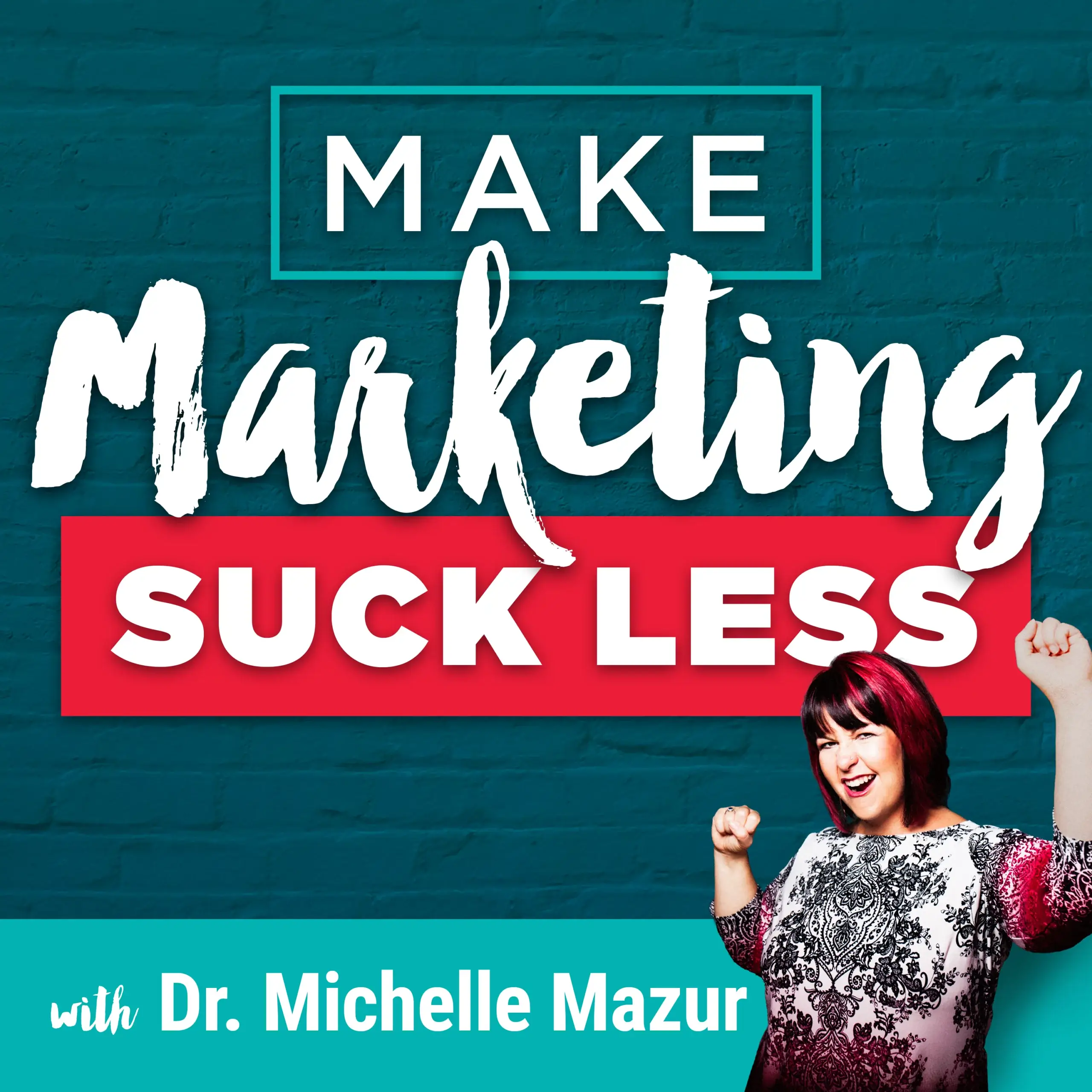Make Marketing Suck Less
How Speak to Sell Formulas Manipulate Audiences into Making Irrational Buying Decisions
By Michelle Mazur > June 14, 2016
Filed Under Public Speaking

“Run to the back of the room. This offer is only good for today. You’ll never be able to get this price again. You deserve to invest in yourself.”
If you’ve hung around this blog for awhile, you know how I feel about selling from the stage.
If you’re new to me and this rebellious blog, welcome and…
Table of Contents
- 1 Speak to sell is ruining public speaking.
- 2 101 Ways to Exploit the Work of Robert Cialdini
- 3 A million little yes’s
- 4 Peer pressure from social proof
- 5 The scarcity play
- 6 Liking the speaker is detrimental to your financial well-being
- 7 Fake Reciprocity – You OWE the Speaker NOTHING
- 8 Best Defense Against The Speak to Sell Dark Arts: THINKING
Speak to sell is ruining public speaking.
Why is that? Because selling from the stage violates the fundamental rule (the one rule this rebel believes in 100%) that PUBLIC SPEAKING IS NOT ABOUT YOU.
It’s about the audience.
Selling from the stage makes the speech about the speaker not the audience.
There’s a big, bad systemic reason why speakers need to sell from the stage even if it makes them feel icky (that will be revealed in an upcoming post).
I’m on a mission to stop this practice and to show everyone that there’s a better way to integrate speaking as part of your business (more on that topic next week).
Or to quote Daenerys Targaryen:
“I’m not going to stop the wheel. I’m going to break the wheel.”
To do that, first I want to tell you how to protect yourself when you inevitably find yourself in the audience of one of these speak-to-sell speeches.
101 Ways to Exploit the Work of Robert Cialdini
In Robert Cialdini’s seminal book Influence, he describes mental triggers that help us process persuasive messages without really thinking about it.
We are forced to make thousands of decisions a day. Imagine if you walked into a grocery store and had to careful evaluate what brand of coffee to buy. Weighing the pros and cons of each and every brand and variety before making a purchase decision.
Exhausting, right?
Instead, we rely on the familiarity & liking mental trigger to make a quick decision decision. I like Peet’s coffee. Peet’s coffee goes into my cart. I’m on to the next aisle.
Cialdini call this Click-whirr processing, and it’s awesome for low risk decisions. A decision, that if you choose unwisely, might result in you losing a couple bucks and throwing some crappy coffee in the trash.
However, these mental triggers are being applied to high risk situations where you are asked to spend hundreds if not thousand of dollars when a speaker makes the offer from the stage.
Those expensive types of decisions should be carefully weighed, thoroughly thought about before a decision is reached. (Much like you would research and critically think about what kind of car you would buy).
Cialdini wrote the book to protect you and I from being taken advantage of by the exploitation of the mental triggers he discusses in his book.
[Tweet “Defend yourself from the speak to sell dark arts”]
Instead, people like Lisa Sasevich & Callan Rush are using all of these persuasive mental triggers to shut down their audience’s thinking and push them to make click-whirr decisions about pricey programs and products. One of the programs they sell is how to sell from the stage using the same sleazy tactics they used.
Speak-to-sell formulas like these use many of these triggers (like commitment and consistency, liking, reciprocity and social proof) in tandem to shut down your rational mind and cause you to make irrational purchase decisions.
These decisions have cost people tens of thousands of dollars in cash with few results, not to mention wasted time.
(By the way, it’s not just speak-to-sell formulas but many online tactics use the work of Cialdini in this fashion. Kelly Diel’s has an excellent piece about Jeff Walker’s abuse of the authority trigger in his Launch formula.)
In order for you to be a savvy consumer, let’s identify these triggers so that you know them when you hear them, discuss why they are so darn effective, and finally present ways that you can effectively combat the persuasion dark arts.
Let’s do this!
A million little yes’s

“Can I tell you my story?” the speaker asks.
Since the audience isn’t full of jerk faces, they reply with “Yes.”
“Do you want to know what happens next?” the speaker asks.
“Yes” the audience says back.
“Can I tell you about how I work with people?”
“Yes” the audience says back.
If you’ve found yourself trapped during a speak-to-sell speech, then you might have noticed that the speakers ask a million yes or no questions.
Callan Rush teaches this method of speaking. She tells her students that you ask permission to tell you story to be respectful of their time. After all, they are not there to hear about you so get permission first. It’s the polite thing to do.
Sounds lovely right? Getting permission to tell your story. How courteous!
Except that what seems like courtesy is hiding a sneaky persuasive trigger that Robert Cialdini calls commit and consistency.
What’s happening is that by getting the audience to say yes to a series of micro-commitments, you’re establishing a pattern (and some argue that you’re changing their identity with each little yes).
The more they say “yes,” the more they become the type of person who says yes to the speaker’s request.
Then when an offer is made at the end of the presentation, it’s consistent with their past behavior to say “Yes, I’ll buy it!” Whip out their credit card and go further into debt.
If they say no, it triggers what psychologist call cognitive dissonance which is an uncomfortable tension or anxiety when you hold two conflicting beliefs at the same time.
If you’re the type of person who said yes to the speaker, it’s going to feel bad to say no. To relieve the anxiety, theeasiest choicee is to change your answer from no to yes.
The whole point of speak-to-sell formulas is to ratchet up the buying tension and the anxiety in the room to the point where the only way to relieve that tension is to buy.
It’s manipulation to the core.
But this insidious micro-commitment scheme has another wallop it packs on the manipulation of the audience.
It leads us to decision fatigue.
According to psychologists: “decision fatigue refers to the deteriorating quality of decisions made by an individual, after a long session of decision making. It is now understood as one of the causes of irrational trade-offs in decision making.”
President Obama wears the same suit nearly every day. Why? He doesn’t want to waste his decision making energy on something silly like figuring out what tie to choose.
Every decision you make. Every yes you say during a speech is meant for one thing and one thing only – to wear you out.
The goal is to shut down your rational brain that thinks about large decisions and to drain your energy so that you make an irrational decision.
Like spending $5000 on a group coaching program.
Defense Against the Persuasion Dark Arts: Here’s the first way you can defend yourself: refuse to make a decision. Do not participate in the yes/no ask-a-thon (and that’s hard because of the next persuasive trigger…social proof). Save your decision making energy for the inevitable ask.
Peer pressure from social proof

“Go to the back of the room to purchase my awesome program.”
Inevitably some soul in the audience pops up from his seat and runs to the back of the room.
Then what happens?
Another person jumps up. Then a couple of more people sprint to the back room. It’s like watching popcorn pop.
When you’re unsure about what to do in a situation, we take cues from what other people around us are doing.
Not sure what fork to use at the table? Look around and see what everyone is doing. Follow their lead.
If you’re not sure that you want to buy what the speaker is selling to you, people running to the back of the room to lay down their hard earned cash is super persuasive.
What do all of those people who are saying YES know that you don’t know? If it’s right for them, it should be right for you. After all, you really enjoyed talking to Jeff over lunch and he’s buying the program.
Maybe you should buy it too?
No, you should absolutely should not base your purchasing decisions based on what the crowd is doing.
It reminds me of something my mom (rest her soul) said when I was growing up, “If all your friends jumped off a bridge, would you jump too?”
As a 14-year old, the answer was yes, but as someone who studied persuasion as part of her academic upbring the answer now is HELL NO!
Defense Against the Persuasion Dark Arts: When you see the first person jump up and charge the back-to-the-room, I want you to think PLANT. Heck, visualize that person as a fern running to spend money. Honestly, there’s a good chance that person was planted in the audience to start the feeding frenzy.
The scarcity play

“You can only get this price TODAY. I won’t be offering this deal ever again.”
Speak-to-sell formulas teach that you’ve got to limit the time a deal is available otherwise people won’t want to buy.
Creating a sense of urgency – buy now or never – is the key to closing the deal. (It works! If you ever launched a class, service, product or held an event, most of your sales comes on the last day).
Scarcity triggers our fear of missing out (FOMO) and we anticipate regretting missing out on something that perhaps we might want.
But let me let you in on a little secret, the scarcity play when selling from the stage is fake scarcity.
A speak-to-sell speech is a like a political stump speech. The speaker is going to be giving it again and most likely very soon.
If you saw this speaker twice, you’d hear the same speech with the same offer and guess what – you’d get the same today only deal.
There’s a difference between real scarcity (there are only 10-spots available or the class starts tomorrow) and fake scarcity (only 20 copies of the ebook left or you’ll never get this price again).
Know the difference between real and fake scarcity. Don’t fall for the scarcity play!
Defense Against the Persuasion Dark Arts: Before whipping out your credit card because you might never get this deal again, STOP and ask yourself is this REAL or FAKE scarcity. Better yet make a deal with a friend that you go with at this event, that you’ll discuss any purchase decision with her to see if FOMO is getting to you or because it’s a sound decision.
Liking the speaker is detrimental to your financial well-being

We buy from people that we know, like, and trust. That’s buying psychology 101.
How do speakers get their audience to like them (to really, really like them)?
They tell them their story. The trials and tribulations they faced. How they overcame those trials. They make you, the audience, feel through their story that they are just like you.
“I’ve been where you are now. And if I can do it. You can do it too.”
This is the tricky part. As a speaker, you want your audience to identify with you, to laugh with you, feel your frustration, and to learn from your experience. It’s a part of excellent speech making.
And when this superpower is used for good, it’s an amazing way to connect. When it’s used to sell, it’s down right dangerous.
But liking someone can be downright detrimental advice and cause us to make risky buying decisions.
My advice is to view a speech like a date – not even a date – more like a quick meet-up for coffee to see if you should start dating.
Most likely, you know very little about the speaker. You’ve seen their bio, their talk title and takeaways, and maybe you checked out their website and social media profiles (and that’s a big maybe).
They are a stranger. Yet, this stranger on the stage, after delivering a 25-minute talk is asking you to INVEST your money.
Imagine if you were on a coffee date. Things seemed to be going well. Your date was charming, funny, and told great stories. You liked their energy and vibe.
Then….
…they asked you for your social security number so that you could buy your dream home together.
You’d sprint away from that Starbucks without looking back.
It’s the same for speakers who sell from the stage except you haven’t even had a personal conversation with them.
After a 20-minute speech (where sure they’ve given you great content), they ask you to buy their $500, $1000, $10,000 or $20,000 program.
It’s time to sprint away.
The fact is they have not built the relationship with you that is necessary to allow them to make this large of an ask.
You’re not buying a diet coke (a low-risk) investment instead they are asking you to take a big risk on investing in a program that you’ve not fully vetted.
The higher the investment, the more risk to you, and the more you need to think about the decision.
It doesn’t matter how much you like someone. It matters that you make a wise investment of your time and money.
Defense Against the Persuasion Dark Arts: Ask yourself “do you like the speaker more than you should after a 20-minutes?” And the answer to this question is YES always yes. If you’re interested in what they have to offer, do not buy now (remember you can get the deal later). Instead investigate them further. Check out their website, read their testimonials, ask for case studies. Vet the person and their offer thoroughly.
Fake Reciprocity – You OWE the Speaker NOTHING

Finally, we arrive at one of the most subtle of all persuasive triggers, reciprocity.
You’ll know this trigger is in play if you hear something like “Did you get a lot of useful information today?” (Yikes another yes/no question). When the audience responds back, the speaker says something like “Since I’ve been so helpful to you, will you do something for me?”
Right there reciprocity is triggered within the audience.
Reciprocity is an instinct that all humans have. When someone gives to us, we like to give back. We don’t like to feel in the debt of others.
Someone compliments you, and you compliment them back.
You get a free cream puff at Costco, and you buy 6 more cream puffs.
A speaker gives you great content, and then you drop a $1,000 on their program.
Does something seem out of whack there? Like the trade-off just isn’t fair?
You’re right. The exchange being suggested by the speaker isn’t fair.
You owe the speaker NOTHING.
As an audience member, you’ve given the speaker your time and attention.
In exchange for your time, the speaker gives you amazing, helpful content that you can use to take action.
Speak-to-sell formulas are based on tit-for-tat reciprocity. The pull to not feel in-debt is undeniable.
But you owe the speaker nothing, and you don’t need to “over-reciprocate” for the content that is delivered.
Defense Against the Persuasion Dark Arts: Remind yourself what the real exchange is in a presentation. Your time and attention for the content and experience of the speech. If you feel a pull to reciprocate more, ask yourself if the value you’re about to exchange (cold-hard cash) is proportional to what the speaker gave you.
Best Defense Against The Speak to Sell Dark Arts: THINKING
Speak-to-sell formulas are based on persuasive triggers that aim to do one thing: shut down your thinking and get you to buy automatically.
When they are used in tandem, they are super effective in getting the audience to buy.
However, the audience then goes on to regret the decision they made in the heat of the moment, and resents the speaker for pressuring them into a buying decision afterwards.
Your best defense against selling from the stage (or any high risk purchase decision from buying a timeshare to enrolling in Drumpf University) is to use your brain.
Don’t be rushed into making a decision because the offer will come back around.
Just because you said “yes” 20 times earlier in a speech. Doesn’t mean you have to say yes to the offer.
Think about the pros/cons of the investment. Will you get a return on the investment? Is this person the “right” person for you to work with? Are their testimonials all about how “great they are” or are they about the results their clients see.
Protect yourself by THINKING in this crazy speak to sell, online world that we live in.
And if you’re a speaker thinking “I don’t want to sell from the stage, but I want to make money speaking” stay tuned for next week when I’ll walk you through a better, more ethical way to monetize your speaking.
Create Your One-of-a-Kind Message
Your 3 Word Rebellion is the Key to Growing Your Business & Impact






